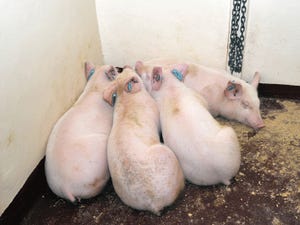U.S. pork producers still optimistic despite trade smackdown
It may be rocky for America's pig farmers but the world is still demanding U.S. pork.
June 7, 2018

U.S. pork is taking a hit, being one of the first agriculture products slapped with punitive tariffs by China and now Mexico. Yet, America’s pig farmers are taking it all in stride here at the World Pork Expo.
China imposes 25% tariff in April while Mexico this week levied escalating punitive tariffs on unprocessed pork in retaliation to Trump’s administration’s tariffs on steel and aluminum imports.
U.S. pork producers have lost $2.2 billion on an annualized basis due to events leading up to and following China’s 25% punitive tariffs alone, according to Iowa State University economist Dermot Hayes.
“A lot of value has been lost in the industry. These are tough financial times, but producers are hanging tough,” Nick Giordano, National Pork Producers Council vice president and counsel of global government affairs, says. “Really, they are patriots here.”
Last year, the United States exported nearly 27% of pork production and added $53.47 per head to producers’ hog prices. U.S. pig farmers are the most-efficient, low-cost producers of the safest pork in the world, but barriers to market access harm producers’ profits.
“We (pork producers) are the ones taking on the chin,” notes Giordano. “A lot of innocent pork producers who are bystanders in this, who employ a lot of people and do a lot of good things are taking on water fast. The best thing the general public can do is — very simple — eat more pork.”
Pork producers’ returns are most likely to drop below breakeven levels with the market disruption, which can trigger anxiety to build among pig farmers.
However, Neil Dierks, NPPC CEO, says most producers have a long view, and they understand trade disagreements take time to be resolved. “You don’t start on Friday and get done the following Tuesday. They take time. Most producers understand that.”
The U.S. pork industry together with the U.S. Meat Export Federation spent so much time developing relationships with Mexico — the No. 1 volume market for pork. U.S. hog farmers fill a need in the country and that is supplying Mexicans with safe, wholesome pork.
Dierks says the Trump administration understands how difficult this is for U.S. pig farmers and is trying to work through the situation. “It is the long game we are in, and we have to have a long-term view because exports mean opportunity for hog farmers and rural America.”
While the current trade disputes in China and Mexico are ugly, pork leaders are rooting for a positive outcome.
Meanwhile, the U.S. pork industry is continuing its work to develop and maintain market access for U.S. pork beyond China and Mexico.
“We are going over some rocky times right now, but we are still really positive,” says David Herring, NPPC president-elect. “If you look at the metrics, there is more pork getting consumed in the world today than ever, and there is demand for our pork. When we get through these rocky times, I think the capital that has been put into this industry has been well spent.”
The world has an appetite for U.S. pork.
“We feed people; that is what we do. We produce a very nutritional, safe product, and there are people all over this world that want it. We are very optimistic about it,” notes Herring.
You May Also Like



